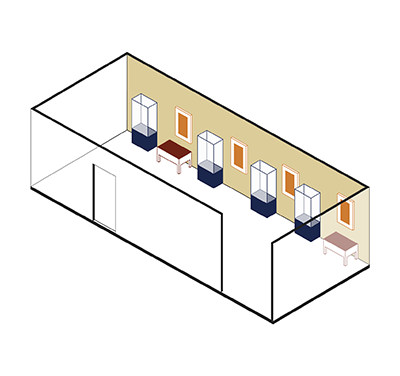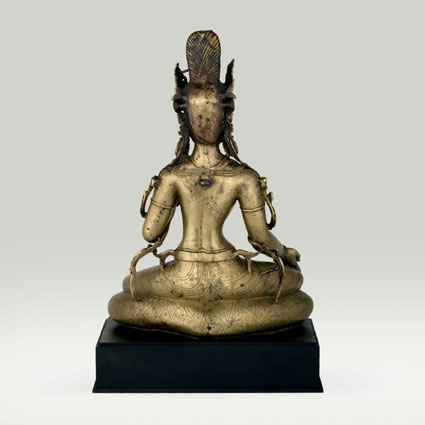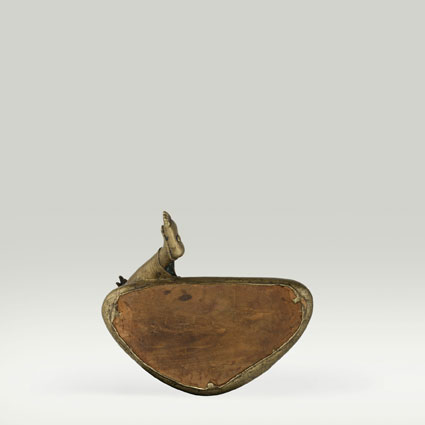
ABS 120
Code: ABS 120
Country: Tibet
Style:
Date: 1100 - 1200
Dimensions in cm WxHxD: 23.2 x 39 x 20.9
Materials: Brass; inlaid with silver and copper
Hollow cast in one piece.
The eyes and urna are inlaid with "silver", the lower lip and three circular ornaments on the belt with copper.
The crown is inset with three turquoises and the pendant of the necklace with a small coral.
The garment and the cushion are decorated with engraved linear patterns and clusters of dots.
The bottom of the pedestal is sealed with wood.
The bodhisattva of compassion is seated in the attitude of ease (lalitasana) on a cushion. He extends the right hand in the gesture of charity (varada mudra) and displays the gesture of emptiness (shuni mudra) with the left hand while holding the stalk of a flower originally blossoming above the left shoulder. Another flower, which is also broken, was originally blossoming above the right shoulder. Avalokiteshvara is clad with a cloth tied around the waist with a belt. He wears jewelled ornaments, namely a three-pointed crown in front of the tall matted hair, a pair of circular earrings, two necklaces with attached pendants, and ornaments at the upper arms, wrists and ankles.
It is interesting to note that the pedestal is not fashioned in the shape of a lotus pedestal but instead represents a cushion. This follows the tradition of the images of Sarasvati cast during the sPu rgyal Period.
Arènes, Pierre, 1996. La déesse sGrol-ma (Tara). Leuven: Uitgeverij Peeters en Departement Oriëntalistiek. References to the iconography of Tara
Beyer, Stephan, 1978. The Cult of the Tara - Magic and Ritual in Tibet. Berkeley: University of California Press. References to the iconography of Tara
Bhattacharyya, Benoytosh , 1958. Indian Buddhist Iconography. Calcutta: K. L. Mukhopadhyay. Pp. 128–29, 131, 135, 189–90, 226–32, 240–43, 249–50, 306–9 - References to the iconography of Tara
Bokar Rimpoché, 2005. Tara l'éveil au féminin. Claire Lumiere. Pp. 23-33 - References to the iconography of Tara
de Mallmann, Marie-Thérèse, 1975. Introduction à l'iconographie du tântrisme bouddhique. Paris: Adrien Mainsonneuve (Jean Maisonneuve successeur (1970). Pp. 369–70 - References to the iconography the “green Tara”
de Mallmann, Marie-Thérèse, 1975. Introduction à l'iconographie du tântrisme bouddhique. Paris: Adrien Mainsonneuve (Jean Maisonneuve successeur (1970). Pp. 368-379 - References to the iconography of Tara
Gosh, Mallar, 1980. Development of Buddhist Iconography in Eastern India: A Study of Tara, Prajnas of Five Tathagatas and Bhrikuti. New Dehli: Hard Bound English Munshiram Manoharlal Publishers (P) Ltd. References to the iconography of Tara
Kumar, Pushpendra, 1992. Tara, the Supreme Goddess. Delhi: Bharatiya Vidya Prakashan. References to the iconography of Tara
Midal, Fabrice, 2000. Mythes et dieux tibétains. Une entrée dans le monde sacré.. Edition du Seuil.
Sèngué, Tcheuky, 2002. Petite Encyclopédie des Divinités et symboles du Bouddhisme Tibétain. Editions Claire Lumiere . Pp. 240-241 - References to the iconography of Tara
von Schroeder, Ulrich, 2010. Buddhist Sculptures of the Alain Bordier Foundation. Hong Kong: Visual Dharma Publications, Ltd.. Pp. 40–41; plate 17B
Wilson, Martin, 1986. In Praise of Tara: Songs to the Saviouress. London: Wisdom Publ. rev. edition 1996 - References to the iconography of Tara





